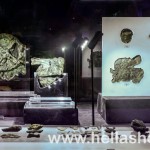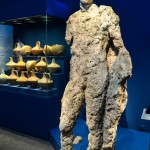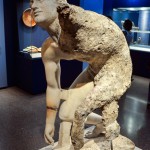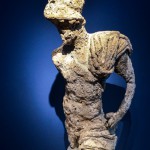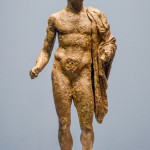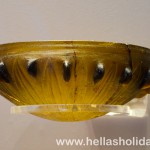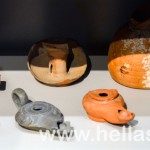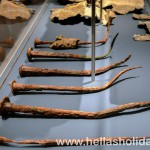 The Antikythera Shipwreck
The Antikythera Shipwreck
A heavy storm more than 2,000 years ago was the cause of a treasure of tremendous archaeological and technological importance to disappear in the deep sea in what is known as the Antikythera Shipwreck (Greek: Ναυάγιο των Αντικυθήρων), where it remained hidden until AD 1900, when another heavy storm became the cause of it to come back to light. But let’s take the story from the… middle!
Discovery of the Antikythera Shipwreck
In November of the year 1900, sponge divers from the island of Symi found themselves looking for sponges in the Aegean Sea, just off the island of Antikythera (between the islands of Kythera and Crete), when a heavy storm broke. In order to protect themselves and their cargo, the spongers sailed near the island to find shelter. The next day the sea had calmed and the spongers set off to fish for sponges again, when they thought they could try their luck just off the island. They dived into the deep sea, in a site of variable depth ranging from approximately 45 up to 70 metres, only to discover an ancient shipwreck.
Retrieval of the Antikythera Treasures
The incident and exact location of the wreck was made known to the Archaeological Service of Greece and a big expedition to recover the antiquities from the bottom of the sea started. This was the first major underwater archaeological expedition in history and it was carried out during the period 1900–1901 by Symian sponge divers with the assistance of the Greek Royal (at the time) Navy. The second phase of the shipwreck’s recovery took place in 1976. During this operation, which was undertaken by the Greek Archaeological Service and Jacques-Yves Cousteau‘s oceanographic, Calypso, a significant part of the cargo was retrieved. Since then, no other expedition had visited the spot of the shipwreck until last October, when a team from the Woods Hole Oceanographic Institute (WHOI), under the supervision of the Ephorate of Underwater Antiquities of Greece, traversed the island and the site of the shipwreck. This last survey revealed that the vessel was almost 50 metres long, which is a gigantic size for ancient times and twice as large as what had been speculated until recently. The survey will continue for another two years, hoping to recover more parts of the boat’s load and uncover more secrets of what is considered a rather peculiar cargo boat.
Facts and speculations about the Antikythera Shipwreck
The Shipwreck of Antikythera happened off the east coast of Antikythera, sometime between the period 70–50 BC. This estimation is mainly based on the coins that were found at the location. Thirty-six silver cistophoric coins from Ephesus and Pergamon (these were the currency of west Asia Minor and they took the name “cistophorus“, because of the sacred chest —or “cista” in Latin— of Dionysus, which was minted on their obverse), as well as several copper coins among which three have been identified as Sicilian and another three came from Asia Minor.
It is believed that the cargo boat was sailing from the east Aegean Sea, possibly from Delos, Pergamon or Ephesus with destination the Roman port of Puteoli (today known as Pozzuoli) in the bay of Naples in Italy. There has been a long debate among scientists as to whether the ship carried the plunder of a Roman loot returning from Greece, in the period when the expanding Roman Republic was seizing the reins of the Mediterranean world, or simply luxury goods destined for the Roman elite.
Based on its sturdy construction, its equipment and the load it carried, the boat must have been a freighter (ancient Greek: ολκάς) of an estimated capacity of 300 tonnes, although new evidence coming from the aforementioned ongoing survey may prove this number to be significantly larger.
The Antikythera Shipwreck Treasures
The load of the cargo boat included articles originating from Rhodes, Delos, Pergamon, Egypt, Antioch and the Syrian-Palestinian coast. Among the 300 specimens that were recovered from the spot of the shipwreck, there were statues and statuettes, coins, utensils, jewellery, glassware and pottery, as well as parts of at least three copper couch-beds. A few small parts of the cargo boat itself have also been retrieved and include wooden fragments, copper nails and recently a lead anchor, which was actually found in a stowed position, indicating that the boat must have sank rather unexpectedly, possibly by being pushed by the wind and the waves against an underwater cliff.
The most impressive part of the cargo is surely the Antikythera Mechanism (a powerful astronomical calculator, which I talk about in the article “Antikythera Mechanism: World’s Oldest Portable Computer“) and —of course— the sculptures; the Antikythera Ephebe (or Antikythera Youth; Greek: Έφηβος των Αντικυθήρων), which is an impressive statue of a young man (height: 1.96 metres) sculpted out of copper between the 340–330 BC and which could be representing Apollo, Hermes, Paris of Troy, Perseus or Hercules; the Antikythera Philosopher, which is another statue made from copper, sculpted around the 230 BC or slightly later; the statue of Hermes (height: 1.93 metres) made in the beginning of the first century BC from Parian marble (marble coming from the island of Paros) and the statue of a wrestling boy also made from Parian marble. Particularly impressive is also the glassware found at the site of the wreck, consisting so far of 20 intact or fragmented luxurious glass utensils of exceptional rarity and beauty, which clearly did not form part of the freighter’s equipment; rather they must have been destined for Italy’s markets.
The Exhibition “Antikythera Shipwreck: the Ship – the Treasures – the Mechanism”
The findings from the Antikythera Shipwreck are exposed for the first time at the National Archaeological Museum of Athens in a temporary exhibition, which was inaugurated on the 5th of April 2012 and will be up until the 28th of April 2013. Among the recent exhibitions of the National Archaeological Museum of Athens, this is actually the one with the most extended duration, and this is because of its expected high popularity. Indeed, the exhibition has already been admired by a record number of visitors compared to all other temporary exhibitions presented in the same museum.
I would strongly advise anyone not to miss the Antikythera Shipwreck exhibition. It is absolutely stunning and undoubtedly unique! And if you cannot make it to the museum until the 28th of April (now extended until the 31st of August 2013), do not worry; the Antikythera Shipwreck findings will take their permanent positions in the National Archaeological Museum of Athens, and will keep being proudly exhibited there, just not as a dedicated temporary exhibition.
If you would like to know more about the National Archaeological Museum of Athens, including information about its collections, permanent and temporary exhibitions, as well as opening hours, you can visit its official website here.
- The Antikythera Mechanism: An overview of major and minor fragments, 2nd century BC
- The Antikythera Ephebe: Youth statue retrieved from the shipwreck, 4th century BC
- The Philosopher of Antikythera, 3rd century BC
- Statue of Hermes retrieved from the Antikythera Shipwreck, 1st century BC
- Marble statue of wrestling boy, 1st century BC
- Statue of helmeted warrior retrieved from the Antikythera Shipwreck
- Statuette of young man
- Marble hand retrieved from the Antikythera Shipwreck
- Golden and gemmed earrings found at the Antikythera Shipwreck, 2nd century BC
- Tinted-glass bowl found at the Antikythera Shipwreck
- Tinted-glass bowl
- Mosaic glass bowls, 1st century BC
- Glass bowl with embossed pattern
- Quern found at the site of the Antikythera Shipwreck, 1st century BC
- Lamps from the Antikythera Shipwreck
- Amphorae retrieved from the Antikythera Shipwreck
- Amphorae at the bottom of the sea: Reconstruction scene of the Antikythera Shipwreck
- Nails and wooden parts of the Antikythera Shipwreck

